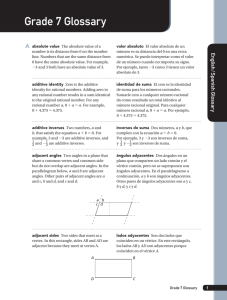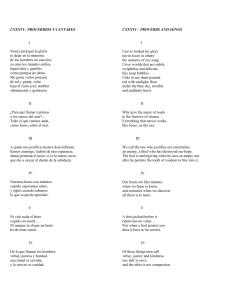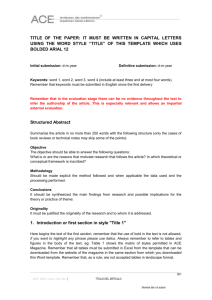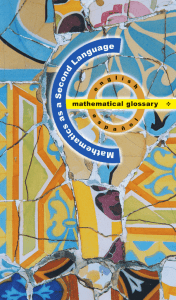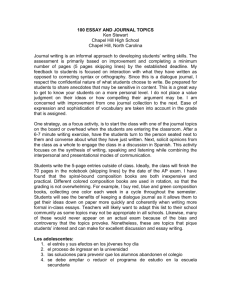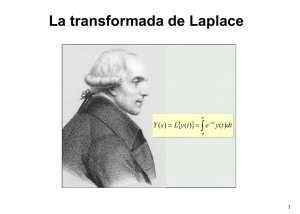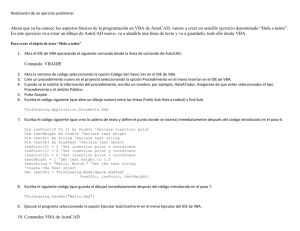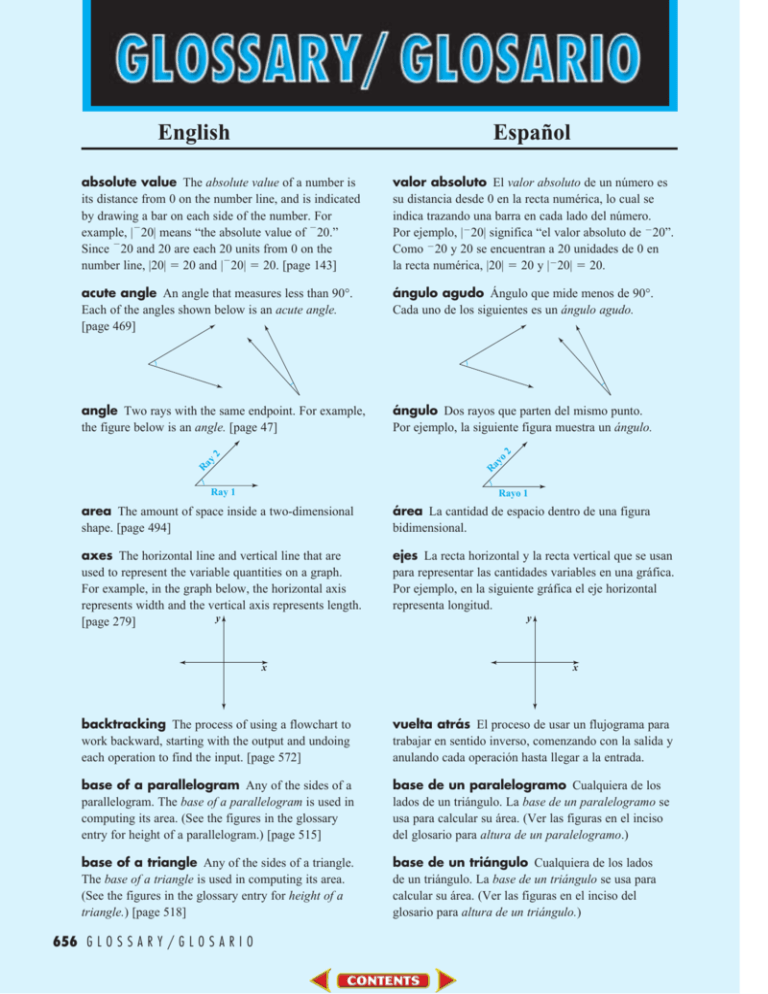
English
Español
valor absoluto El valor absoluto de un número es
su distancia desde 0 en la recta numérica, lo cual se
indica trazando una barra en cada lado del número.
Por ejemplo, |20| significa “el valor absoluto de 20”.
Como 20 y 20 se encuentran a 20 unidades de 0 en
la recta numérica, |20| 20 y |20| 20.
acute angle An angle that measures less than 90°.
Each of the angles shown below is an acute angle.
[page 469]
ángulo agudo Ángulo que mide menos de 90°.
Cada uno de los siguientes es un ángulo agudo.
angle Two rays with the same endpoint. For example,
the figure below is an angle. [page 47]
ángulo Dos rayos que parten del mismo punto.
Por ejemplo, la siguiente figura muestra un ángulo.
ay
2
absolute value The absolute value of a number is
its distance from 0 on the number line, and is indicated
by drawing a bar on each side of the number. For
example, |20| means “the absolute value of 20.”
Since 20 and 20 are each 20 units from 0 on the
number line, |20| 20 and |20| 20. [page 143]
R
R
Ray 1
ay
o
2
Rayo 1
area The amount of space inside a two-dimensional
shape. [page 494]
área La cantidad de espacio dentro de una figura
bidimensional.
axes The horizontal line and vertical line that are
used to represent the variable quantities on a graph.
For example, in the graph below, the horizontal axis
represents width and the vertical axis represents length.
y
[page 279]
ejes La recta horizontal y la recta vertical que se usan
para representar las cantidades variables en una gráfica.
Por ejemplo, en la siguiente gráfica el eje horizontal
representa longitud.
x
y
x
backtracking The process of using a flowchart to
work backward, starting with the output and undoing
each operation to find the input. [page 572]
vuelta atrás El proceso de usar un flujograma para
trabajar en sentido inverso, comenzando con la salida y
anulando cada operación hasta llegar a la entrada.
base of a parallelogram Any of the sides of a
parallelogram. The base of a parallelogram is used in
computing its area. (See the figures in the glossary
entry for height of a parallelogram.) [page 515]
base de un paralelogramo Cualquiera de los
lados de un triángulo. La base de un paralelogramo se
usa para calcular su área. (Ver las figuras en el inciso
del glosario para altura de un paralelogramo.)
base of a triangle Any of the sides of a triangle.
The base of a triangle is used in computing its area.
(See the figures in the glossary entry for height of a
triangle.) [page 518]
base de un triángulo Cualquiera de los lados
de un triángulo. La base de un triángulo se usa para
calcular su área. (Ver las figuras en el inciso del
glosario para altura de un triángulo.)
656 G L O S S A R Y / G L O S A R I O
English
Español
chord A segment connecting two points on a circle.
(See the figure in the glossary entry for radius. This
figure shows a chord of a circle.) [page 486]
cuerda Segmento que conecta dos puntos en un
círculo. (Ver la figura en el inciso del glosario para
radio. Dicha figura muestra una cuerda de un círculo.)
circumference The perimeter of a circle (distance
around a circle). [page 486]
circunferencia El perímetro de un círculo (distancia
alrededor del círculo).
common factor A common factor of two or more
numbers is a number that is a factor of all the numbers.
For example, 5 is a common factor of 15, 25, and 40.
[page 82]
factor común Un factor común de dos o más
números es un número que es un factor de todos los
números. Por ejemplo, 5 es un factor común de 15,
25 y 40.
common multiple A common multiple of a set of
numbers is a multiple of all the numbers. For example,
24 is a common multiple of 3, 8, and 12. [page 85]
múltiplo común Un múltiplo común de un conjunto
de números es un múltiplo de todos los números. Por
ejemplo, 24 es un múltiplo común de 3, 8 y 12.
composite number A whole number greater than 1
with more than two factors. For example, 12 is a
composite number since it is greater than 1 and has
more than two factors. In fact, it has six factors: 1, 2, 3,
4, 6, and 12. [page 80]
número compuesto Un número entero mayor
que 1 con más de dos factores. Por ejemplo, 12 es un
número compuesto dado que es mayor que 1 y tiene
más de dos factores. De hecho, tiene seis factores:
1, 2, 3, 4, 6 y 12.
concave polygon A polygon that looks like it is
“collapsed” or has a “dent” on one or more sides. Any
polygon with an angle measuring more than 180° is
concave. The figures below are concave polygons.
[page 50]
polígono cóncavo Polígono que parece que se
hubiera “hundido” o que tiene una hendidura en uno
más de sus lados. Cualquier polígono con un ángulo
mayor que 180° es cóncavo. Las siguientes figuras son
polígonos cóncavos.
coordinates Numbers that represent the location of a
point on a graph. For example, if a point is 3 units to
the right and 7 units up from the origin, its coordinates
are 3 and 7. [page 302]
coordenadas Números que representan la posición
de un punto en una gráfica. Por ejemplo, si un punto se
encuentra a 3 unidades a la derecha y 7 unidades hacia
arriba del origen, sus coordenadas son 3 y 7.
diameter A chord that passes through the center of a
circle. Diameter also refers to the distance across a
circle through its center. (See the figure in the glossary
entry for radius. This figure shows a diameter of a
circle.) [page 486]
diámetro Cuerda que pasa por el centro de un
círculo. El diámetro también se refiere a la distancia a
través de un círculo, pasando por su centro. (Ver las
figuras en el inciso del glosario para radio. Dicha figura
muestra un diámetro de un círculo.)
distribution The distribution of a data set shows
how the data are spread out, where there are gaps,
where there are lots of values, and where there are
only a few values. [page 351]
distribución La distribución de un conjunto de datos
muestra la extensión de los datos, las brechas entre los
datos, los lugares donde hay muchos valores y donde
hay pocos valores.
equally likely Outcomes of a situation or
experiment that have the same probability of occurring.
For example, if one coin is tossed, coming up heads and
coming up tails are equally likely outcomes. [page 608]
equiprobables Resultados de una situación o
experimento que tienen la misma posibilidad de ocurrir.
Por ejemplo, si se lanza una moneda, es equiprobable
que la moneda caiga mostrando cara o escudo.
GLOSSARY/GLOSARIO
657
English
Español
equation A mathematical sentence stating that two
quantities have the same value. An equal sign, , is
used to separate the two quantities. For example,
5 8 3 10 is an equation. [page 558]
ecuación Enunciado matemático que establece que
dos cantidades tienen el mismo valor. Se usa un signo
de igualdad, , para comparar las dos cantidades. Por
ejemplo, 5 8 3 10 es una ecuación.
equivalent fractions Fractions that describe the
same portion of a whole, or name the same number.
3 9
30
For example, 4, 1
2 , and 40 are equivalent fractions.
[page 100]
fracciones equivalentes Fracciones que describen
la misma parte de un todo o que representan el mismo
3 9
30
número. Por ejemplo, 4, 12 y 4
0 son fracciones
equivalentes.
experimental probability A probability based
on experimental data. An experimental probability is
always an estimate and can vary depending on the
particular set of data that is used. [page 606]
probabilidad experimental Probabilidad que
se basa en datos experimentales. Una probabilidad
experimental es siempre una estimación y puede variar
según el conjunto de datos en particular que se usen.
exponent A small, raised number that tells how
many times a factor is multiplied. For example, in 103,
the exponent 3 tells you to multiply 3 factors of 10:
10 10 10 1,000. [page 81]
exponente Número pequeño y elevado que indica
cuántas veces se multiplica un factor. Por ejemplo,
en 103, el exponente 3 te indica que multipliques 3
factores de 10: 10 10 10 1,000
factor A factor of a whole number is another whole
number that divides into it without a remainder. For
example, 1, 2, 3, 4, 6, 8, 12, and 24 are factors of 24.
[page 78]
factor Un factor de un número entero es otro
número entero que lo divide sin que quede un
residuo. Por ejemplo, 1, 2, 3, 4, 6, 8, 12 y 24
son factores de 24.
factor pair A factor pair for a number is two factors
whose product equals that number. For example, the
factor pairs for 24 are 1 and 24, 2 and 12, 3 and 8, and
4 and 6. [page 78]
par de factores Un par de factores para un número
consta de dos factores cuyo producto es igual al
número. Por ejemplo, los pares de factores para 24
son 1 y 24; 2 y 12; 3 y 8; y 4 y 6.
flowchart A diagram, using ovals and arrows, that
shows the steps for going from an input to an output.
For example, the diagram below is a flowchart.
[page 571]
flujograma Diagrama que usa óvalos y flechas para
mostrar los pasos a seguir desde un dato de entrada
hasta uno de salida. Por ejemplo, el siguiente diagrama
es un flujograma.
n
4
4n
5
Input
4n 5
n
Output
Entrada
4
4n
5
4n 5
Salida
greatest common factor, GCF The greatest
common factor (often abbreviated GCF) of two or
more numbers is the greatest of their common factors.
For example, the greatest common factor (or GCF) of
24 and 36 is 12. [page 83]
máximo común divisor, MCD El máximo
común divisor (a menudo abreviado, MCD) de dos
números es el mayor de sus factores comunes. Por
ejemplo, el máximo común divisor (o MCD) de 24
y 36 es 12.
guess-check-and-improve A method for solving
an equation that involves first guessing the solution,
then checking the guess by substituting into the original
equation, and then using the result to improve the guess
until the correct solution is found. [page 586]
conjetura, verifica y mejora Método para
resolver una ecuación que implica primero hacer
una conjetura, verificar la conjetura y sustituirla en
la ecuación original y luego usar el resultado para
mejorar la conjetura hasta hallar la solución correcta.
658 G L O S S A R Y / G L O S A R I O
English
Español
height of a parallelogram The distance from
the side opposite the base of a parallelogram to the
base. The height of a parallelogram is always measured
along a segment perpendicular to the base (or to the line
containing the base). The figures below show a base
and the corresponding height for two parallelograms.
[page 515]
Height
Height
Base
Base
height of a triangle The distance from the base
of a triangle to the vertex opposite the base. The height
of a triangle is always measured along a segment
perpendicular to the base (or the line containing the
base). The figures below show a base and the
corresponding height for two triangles. [page 518]
altura de un paralelogramo La distancia desde
el lado opuesto a la base de un paralelogramo, hasta la
base. La altura de un paralelogramo se mide siempre
a lo largo de un segmento perpendicular a la base (o a
la recta que contiene la base). Las siguientes figuras
muestran una base y la altura correspondiente de dos
paralelogramos.
Base
Base
altura de un triángulo La distancia desde la base
de un triángulo hasta el vértice opuesto a la base. La
altura de un triángulo se mide siempre a lo largo de
un segmento perpendicular a la base (o de la recta que
contiene la base). Las siguientes figuras muestran una
base y la altura correspondiente de dos triángulos.
Height
Altura
Height
Base
Altura
Altura
Altura
Base
Base
Base
histogram A bar graph in which data are divided
into equal intervals, with a bar for each interval. The
height of each bar shows the number of data values
in that interval. [page 350]
histograma Gráfica de barras en la cual los datos se
dividen en intervalos iguales, con una barra para cada
intervalo. La altura de cada barra muestra el número de
valores de los datos en ese intervalo.
hypotenuse The side opposite the right angle in a
right triangle. The hypotenuse is the longest side of a
right triangle. (See the figure in the entry for leg
below.) [page 536]
hipotenusa El lado opuesto al ángulo recto en un
triángulo rectángulo. La hipotenusa es el lado más largo
de un triángulo rectángulo. (Ver a continuación la
figura en el inciso del glosario para cateto.)
inequality A mathematical sentence stating that
two quantities have different values. For example,
5 9 12 is an inequality. The symbols , ,
and are used in writing inequalities. [page 559]
desigualdad Enunciado matemático que establece
que dos cantidades tienen distintos valores. Por
ejemplo, 5 9 12 es una desigualdad. Los símbolos
, y se usan para escribir desigualdades.
inverse operations Two operations that “undo”
each other. For example, addition and subtraction are
inverse operations, and multiplication and division are
inverse operations. [page 504]
operaciones inversas Dos operaciones que
se “anulan” entre sí. Por ejemplo, la adición y la
sustracción son operaciones inversas y la multiplicación
y la división son operaciones inversas.
least common multiple, LCM The least common
multiple (often abbreviated LCM) of two or more
numbers is the smallest of their common multiples. For
example, the least common multiple (or LCM) of 6 and
15 is 30. [page 85]
mínimo común múltiplo, mcm El mínimo
común múltiplo (a menudo abreviado mcm) de dos o
más números es el menor de sus múltiplos comunes.
Por ejemplo, el mínimo común múltiplo de 6 y 15
es 30.
GLOSSARY/GLOSARIO
659
English
leg One of the sides of a right
triangle that is not the hypotenuse,
or one of the shorter two sides of a
right triangle. The figure at the right
shows the two legs and hypotenuse
of a right triangle. [page 536]
Español
Hypotenuse
Leg
Leg
Hipotenusa
cateto Uno de los lados de un
triángulo rectángulo que no es la
hipotenusa o uno de los dos
Cateto
Cateto
lados más cortos de un triángulo
rectángulo. La figura muestra los
dos catetos y la hipotenusa de un triángulo rectángulo.
line graph A graph in which points are connected
with line segments. [page 289]
gráfica lineal Gráfica en la cual los puntos se
conectan con segmentos de recta.
line plot A number line with X’s indicating
the number of times each data value occurs.
[page 363]
esquema lineal Recta numérica que contiene equis
que indican el número de veces que ocurre cada valor
de los datos.
line symmetry A polygon has line symmetry
(or reflection symmetry) if you can fold it in half
along a line so that the two halves match exactly.
The polygons below have line symmetry. The lines
of symmetry are shown as dashed lines.
[page 51]
simetría lineal Un polígono tiene simetría lineal
(o simetría de reflexión) si se puede doblar por la mitad
a lo largo de una línea de modo que las dos mitades
coincidan exactamente. Los siguientes polígonos tienen
simetría lineal. Los ejes de simetría se muestran como
líneas punteadas.
lowest terms A fraction is in lowest terms
if its numerator and denominator are relatively
5
prime. For example, 6 is in lowest terms
because the only common factor of 5 and 6 is 1.
[page 100]
en términos reducidos o reducida Una
fracción está en términos reducidos o reducida si su
numerador y denominador son primos relativos. Por
5
ejemplo, 6 está reducida dado que el único factor
común de 5 y 6 es 1.
mean The number you get by distributing the total of
the values in a data set among the members of the data
set. You can compute the mean by adding the values
and dividing the total by the number of values. For
example, for the data 5, 6, 6, 8, 8, 8, 9, 10, 12, the total
of the values is 72 and there are 9 values, so the mean
is 72 9 8. [page 371]
media El número que se obtiene al distribuir el
total de los valores en un conjunto de datos entre los
miembros del conjunto de datos. Se puede calcular la
media sumando los valores y luego dividiendo el total
entre el número de valores. Por ejemplo, para los datos
5, 6, 6, 8, 8, 8, 9, 10, 12, el total de los valores es 72 y
hay 9 valores, de modo que la media es 72 9 8.
median The middle value when all the values in a
data set are ordered from least to greatest. For example,
for the data set 4.5, 6, 7, 7, 8.5, 10.5, 12, 12, 14.5, the
median is 8.5. [page 363]
mediana El valor central cuando todos los valores
en un conjunto de datos se ordenan de menor a mayor.
Por ejemplo, para el conjunto de datos 4.5, 6, 7, 7, 8.5,
10.5, 12, 12, 14.5, la mediana es 8.5.
mixed number A whole number and a fraction.
3
For example 124 is a mixed number. [page 98]
número mixto Un número entero y una fracción.
3
Por ejemplo, 124 es un número mixto.
mode The value in a data set that occurs most often.
For example, for the data set 4.5, 6, 7, 7, 7, 8.5, 10.5,
12, 12, the mode is 7. [page 363]
moda El valor en un conjunto de datos que ocurre
con más frecuencia. Por ejemplo, para el conjunto de
datos 4.5, 6, 7, 7, 7, 8.5, 10.5, 12, 12, la moda es 7.
660 G L O S S A R Y / G L O S A R I O
English
Español
multiple A multiple of a whole number is the
product of that number and another whole number.
For example, 35 is a multiple of 7 since 35 7 5.
[page 85]
múltiplo Un múltiplo de un número entero es
el producto de ese número y otro número entero.
Por ejemplo, 35 es un múltiplo de 7 dado que
35 7 5.
negative number A number that is less than 0. For
example, 18 (read “negative eighteen”) is a negative
number. [page 142]
número negativo Un número menor que 0. Por
ejemplo, 18 (que se lee “dieciocho negativo”) es un
número negativo.
obtuse angle An angle that measures more than 90°
and less than 180°. Each of the angles shown below is
an obtuse angle. [page 469]
ángulo obtuso Ángulo que mide más de 90° y
menos de 180°. Cada uno de los siguientes ángulos
es un ángulo obtuso.
open sentence An equation of inequality that can
be true or false depending on the value of the variable.
For example, 5 n 20 is an open sentence.
[page 560]
enunciado abierto Ecuación de desigualdad que
puede ser verdadera o falsa dependiendo del valor de
la variable. Por ejemplo, 5 n 20 es un enunciado
abierto.
opposites Two numbers that are the same distance
from 0 on the number line, but on different sides of 0.
For example 35 and 35 are opposites. [page 143]
opuestos Dos números equidistantes de 0 en la recta
numérica, pero en lados opuestos de 0. Por ejemplo, 35
y 35 son opuestos.
ordered pair A pair of numbers that represent the
coordinates of a point, with the horizontal coordinate of
the point written first. For example, the point with
horizontal coordinate 3 and vertical coordinate 7 is
represented by the ordered pair (3, 7). [page 302]
par ordenado Un par de números que representa
las coordenadas de un punto, en el cual la coordenada
horizontal del punto se escribe primero. Por ejemplo,
el punto con la coordenada horizontal 3 y coordenada
vertical 7 se representa con el par ordenado (3, 7).
order of operations A convention for reading
and evaluating expressions. The order of operations
says that expressions should be evaluated in this
order:
orden de las operaciones Una convención para
leer y evaluar expresiones. El orden de las operaciones
indica que las expresiones se deben evaluar en el
siguiente orden:
• Evaluate any expressions inside parentheses and
above and below fraction bars.
• Evaluate all exponents, including squares.
• Do multiplications and divisions from left
to right.
• Do additions and subtractions from left to right.
• Evalúa cualquier expresión entre paréntesis y sobre y
debajo de barras de fracciones.
• Evalúa todos los exponentes, incluyendo los cuadrados.
• Efectúa las multiplicaciones y las divisiones de
izquierda a derecha.
• Efectúa las sumas y las restas de izquierda a derecha.
For example, to evaluate 5 3 7, you multiply first
and then add: 5 3 7 5 21 26.
Por ejemplo, para evaluar 5 3 7, multiplica
primero y luego suma. 5 3 7 5 21 26.
To evaluate 102 6 3, you evaluate the exponent
first, then divide, then subtract:
Para evaluar 102 6 3, evalúa primero el exponente,
luego divide y por último resta.
102 6 3 100 6 3 100 2 98.
[pages 19 and 501]
102 6 3 100 6 3 100 2 98.
GLOSSARY/GLOSARIO
661
English
Español
origin The point where the axes of a graph meet. The
origin of a graph is usually the 0 point for each axis.
[page 279]
origen El lugar donde se encuentran los ejes de una
gráfica. El origen de una gráfica es por lo general el
punto 0 de cada eje.
outlier A value that is much greater than or much less
than most of the other values in a data set. For example,
for the data set 6, 8.2, 9.5, 11.6, 14, 30, the value 30 is
an outlier. [page 375]
valor atípico Un valor que es mucho mayor o mucho
menor que la mayoría de los otros valores en un conjunto
de datos. Por ejemplo, para el conjunto de datos 6, 8.2,
9.5, 11.6, 14, 30, el valor 30 es un valor atípico.
parallelogram A quadrilateral with opposite sides
that are the same length. The opposite sides of a
parallelogram are parallel. Each of the figures shown
below is a parallelogram. [page 515]
paralelogramo Cuadrilátero cuyos lados opuestos
tienen la misma longitud. Los lados opuestos de un
paralelogramo son paralelos. Cada una de las
siguientes figuras es un paralelogramo.
percent Percent means “out of 100.” A percent
represents a number as a part out of 100 and is
written with a percent sign. For example, 39%
39
means 39 out of 100, or 100 , or 0.39.
[page 227]
por ciento, porcentaje Por ciento significa
“de cada 100”. Un por ciento representa un número
como una parte de 100 y se escribe con un signo de
porcentaje. Por ejemplo, 39% significa 39 de cada 100
39
ó
100 ó 0.39.
perfect square A number that is equal to a whole
number multiplied by itself. In other words, a perfect
square is the result of squaring a whole number. For
example, 1, 4, 9, 16, and 25 are perfect squares since
these are the results of squaring 1, 2, 3, 4, and 5, in that
order. [page 500]
cuadrado perfecto Número que es igual a un
número entero multiplicado por sí mismo. Es decir, un
cuadrado perfecto es el resultado de elevar al cuadrado
un número entero. Por ejemplo, 1, 4, 9, 16 y 25 son
cuadrados perfectos, dado que son el resultado de
elevar al cuadrado 1, 2, 3, 4 y 5, en ese orden.
perimeter The distance around a two-dimensional
shape. [page 482]
perímetro La distancia alrededor de una figura
bidimensional.
perpendicular Two lines or segments that form
a right angle area are said to be perpendicular. For
example, see the figures below. [page 469]
perpendicular Se dice que dos rectas o segmentos
que forman un ángulo recto son perpendiculares. Por
ejemplo, observa las siguientes figuras.
Perpendicular Lines
Perpendicular Segments
Rectas perpendiculares
Segmentos
perpendiculares
polygon A flat (two-dimensional) geometric figure
that has these characteristics:
polígono Figura geométrica plana (bidimensional)
que posee las siguientes tres características:
• It is made of straight line segments.
• Each segment touches exactly two other segments,
one at each of its endpoints.
• Está compuesta de segmentos de recta
• Cada segmento interseca exactamente otros dos
segmentos, uno en cada uno de sus extremos.
The shapes below are polygons. [page 42]
Las siguientes figuras son polígonos.
662 G L O S S A R Y / G L O S A R I O
English
Español
positive number A number that is greater than 0.
For example, 28 is a positive number. [page 142]
número positivo Número mayor que 0. Por
ejemplo, 28 es un número positivo.
prime factorization The prime factorization of a
composite number shows that number written as a
product of prime numbers. For example, the prime
factorization of 98 is 2 7 7. [page 80]
factorización prima La factorización prima de un
número compuesto muestra ese número escrito como
un producto de números primos. Por ejemplo, la
factorización prima de 98 es 2 7 7.
prime number A whole number greater than 1 with
only two factors: itself and 1. For example, 13 is a
prime number since it only has two factors, 13 and 1.
[page 80]
número primo Número entero mayor que 1 cuyos
únicos factores son 1 y el número mismo. Por ejemplo,
13 es un número primo dado que sólo tiene dos
factores: 13 y 1.
probability The chance that an event will happen,
described as a number between 0 and 1. For example,
the probability of tossing a coin and getting heads is
1
or 50%. A probability of 0 or 0% means the event
2
has no chance of happening, and a probability of 1
or 100% means the event is certain to happen.
[page 605]
probabilidad La oportunidad de que un evento
ocurra, descrita como un número entre 0 y 1. Por
ejemplo, la probabilidad de lanzar una moneda y
1
que ésta caiga mostrando cara es de 2 ó 50%. Una
probabilidad de 0 ó 0% significa que el evento no tiene
oportunidad de ocurrir y una probabilidad de 1 ó 100%
significa que el evento ocurrirá con seguridad.
radius (plural: radii) A segment from the center of
a circle to a point on a circle. Radius also refers to the
distance from the center to a point on a circle. The
figure below shows a chord, a diameter, and a radius of
a circle. [page 486]
Chord
radio Un segmento desde el centro del círculo hasta
un punto del mismo. Radio también se refiere a la
distancia desde el centro hasta un punto del círculo.
La siguiente figura muestra una cuerda, un diámetro
y un radio de un círculo.
Cuerda
Diameter
Diámetro
Radius
Radio
range The difference between the minimum and
maximum values of a data set. For example, for the
data set 4.5, 6, 7, 7, 7, 8.5, 10.5, 12, 12, the range is
12 4.5 7.5. [page 363]
rango La diferencia entre los valores mínimo y
máximo en un conjunto de datos. Por ejemplo, para
el conjunto de datos 4.5, 6, 7, 7, 7, 8.5, 10.5, 12, 12,
el rango es 12 4.5 7.5.
reciprocal Two numbers are reciprocals if their
5
7
product is 1. For example, the reciprocal of 7 is 5.
[page 188]
recíproco Dos números son recíprocos si su
5
producto es 1. Por ejemplo, el recíproco de 7
7
es 5.
regular polygon A polygon with sides that are all
the same length and angles that are all the same size.
The shapes below are regular polygons. [page 50]
polígono regular Polígono cuyos lados son todos
de la misma longitud y cuyos ángulos tienen la misma
medida. Las siguientes figuras son polígonos regulares.
GLOSSARY/GLOSARIO
663
English
Español
relatively prime Two or more numbers are
relatively prime if their only common factor is 1. For
example, 7 and 9 are relatively prime. [page 83]
relativamente primo Dos o más números son
relativamente primos si su único factor común es 1.
Por ejemplo, 7 y 9 son relativamente primos.
repeating decimal A decimal with a pattern
of digits that repeat without stopping. For example,
0.232323 . . . is a repeating decimal. Repeating
decimals are usually written with a bar over the
repeating digits, so 0.232323 . . . can be written
as 0.23. [page 132]
decimal periódico Decimal con un patrón de
dígitos que se repiten indefinidamente. Por ejemplo,
0.232323 . . . es un decimal periódico. Los decimales
periódicos por lo general se escriben con una barra
sobre los dígitos que se repiten, de este modo,
0.232323 . . . se puede escribir como 0.23.
right angle An angle that measures exactly 90°.
Right angles are often marked with a small square at
the vertex. Each angle shown below is a right angle.
[page 469]
ángulo recto Ángulo que mide exactamente 90°.
Los ángulos rectos por lo regular se marcan con un
cuadrado en el vértice. Cada ángulo siguiente es un
ángulo recto.
right triangle A triangle that has one 90° angle.
[page 536]
triángulo rectángulo Triángulo que posee un
ángulo de 90°.
sequence An ordered list. For example, 2, 5, 8, 11,
. . . is a sequence. [page 6]
sucesión Lista ordenada. Por ejemplo, 2, 5, 8, 11, . . .
es una sucesión.
simulation An experiment in which you use
different items to represent the items in a real situation.
For example, to simulate choosing markers and looking
at their colors, you can write the color of each marker
on a slip of paper and put all the slips into a bag. You
can simulate choosing markers by drawing slips from
the bag. Mathematically, the situations are identical.
[page 639]
simulacro Un experimento que usa diferentes
artículos para representar una situación real. Por
ejemplo, en un simulacro para elegir marcadores y
verificar sus colores, puedes escribir el color de cada
marcador en tiras de papel y colocar las tiras en una
bolsa. Saca tiras de la bolsa para llevar a cabo el
experimento de escoger marcadores. Matemáticamente,
las situaciones son idénticas.
solution A value of a variable that makes an equation
true. For example, 4 is the solution of the equation
3n 7 19. [page 560]
solución Un valor de una variable que hace verdadera
una ecuación. Por ejemplo, 4 es la solución de la
ecuación 3n 7 19.
square root The number you need to square to get a
given number. For example, the square root of 36 is 6.
[page 504]
raíz cuadrada El número que debes elevar al
cuadrado para obtener un número dado. Por ejemplo,
la raíz cuadrada de 36 es 6.
stem-and-leaf plot A visual display of data that
groups data, but also allows you to read individual
values. To make a stem-and-leaf plot of data that
are two-digit numbers, use the tens digits as the
stems and the ones digits as the leaves.
[page 366]
diagrama de tallo y hojas Representación
visual de datos, la cual agrupa los datos, pero también
permite leer valores individuales. Para trazar un
diagrama de tallo y hojas de datos de dos dígitos,
usa los dígitos de las decenas como el tallo y los
dígitos de las unidades como las hojas.
664 G L O S S A R Y / G L O S A R I O
English
Español
term An item in a sequence. For example, 8 is a term
in the sequence 2, 5, 8, 11, . . . . [page 6]
término Un artículo en una sucesión. Por ejemplo, 8
es un término de la sucesión 2, 5, 8, 11, . . . .
theoretical probability Probability calculated
by reasoning about the situation. Since theoretical
probabilities do not depend on experiments, they are
always the same for a particular event. [page 608]
probabilidad teórica Probabilidad que se calcula
mediante el razonamiento de la situación. Dado que las
probabilidades teóricas no dependen de experimentos,
son siempre idénticas para un evento en particular.
triangle inequality The triangle inequality
states that the sum of the lengths of any two sides
of a triangle is greater than the length of the third
side. For example, the triangle inequality tells you
that it is impossible to have a triangle with sides
of lengths 4, 5, and 10, since 4 5 is not greater
than 10. [page 56]
desigualdad del triángulo La desigualdad del
triángulo establece que la suma de las longitudes de
cualquier par de lados de un triángulo es mayor que la
longitud del tercer lado. Por ejemplo, la desigualdad
del triángulo indica que es imposible tener un triángulo
cuyos lados miden 4, 5 y 10 de longitud, dado que
4 5 no es mayor que 10.
variable A quantity that varies, or changes. For
example, in a problem about the sizes of buildings, the
height and width of the buildings would be variables.
[page 278]
variable Cantidad que varía o cambia. Por
ejemplo, en un problema sobre el tamaño de
edificios, la altura y el ancho de los edificios
serían variables.
vertex (plural: vertices) A corner of a polygon,
where two sides meet. Vertices are usually labeled with
capital letters, such as A, B, and C for the vertices of a
triangle. [page 44]
vértice La esquina de un polígono, donde se
encuentran dos de sus lados. Por lo general, los vértices
se designan con letras mayúsculas, como por ejemplo,
A, B y C para los vértices de un triángulo.
GLOSSARY/GLOSARIO
665
A
Absolute value of a number, 143–144
Absolute zero, 569
Acute angles, 469
Acute triangles, 546
Addition, 504
common denominators in, 157–160
with fraction pieces, 154–157
of fractions, 154–170
of mixed numbers, 161–163
order of operations in, 412, 501
Algebra, 412
Anagram, 39
Angles, 46–49, 466–481
acute, 469
defined, 47
of elevation, 468
estimating measures of, 466
exterior, 479
interior, 473
investigating relationships,
472–476
measuring, 47–49, 467–473
obtuse, 469
pairs, 472
right, 334, 469
straight, 62
of triangles, 57, 334
vertical, 472–473
Applications
architecture, 218–219
biology, 109
earth science, 41, 147, 330, 353,
358, 616
ecology, 355
economics, 24, 26, 68, 124, 125,
126, 141, 167, 192, 213, 214,
215, 216, 218, 220, 246, 256,
257, 258, 270, 272, 312, 315,
357–358, 444, 449, 512, 513,
569, 581, 583, 584, 637, 651
fine arts, 492
666
INDEX
geometry, 92, 147, 170, 197, 259,
272–273, 311, 315, 330, 334,
361, 389, 426, 459, 535, 550,
569, 584, 594, 596, 597,
637, 651
history, 93
life science, 39, 192, 270, 329, 331,
388, 619, 649
measurement, 23–26, 108, 109,
111, 123–124, 141, 170, 171,
193, 195, 213, 215, 217, 220,
272, 381, 444, 445, 459
number sense, 111, 170, 272, 401,
459, 569, 597
nutrition, 243, 257, 271, 597
physical science, 218, 332–333,
447, 448, 545, 596, 598
physics, 446, 582
science, 125–126, 243, 295, 299,
446, 447, 569
social studies, 94, 241, 243,
296–297, 328, 354, 400, 401
sports, 124, 257, 311, 327, 357,
380, 381, 383, 385, 386, 429,
443, 444, 445, 478, 480, 490,
492, 583, 584
statistics, 66, 110, 127–128, 141,
220, 245, 429, 449, 493, 550,
585, 637
technology, 448, 481
Approximation, 17, 104
of pi, 486–489
of square roots, 506–507
Areas, 494–498
calculating, 514–535
of circles, 522–524, 594
geometric probability, 626–630
maximizing in spreadsheets,
525–527
of parallelograms, 515–517
of rectangles, 175–176, 178, 264,
497–498, 589
of squares, 311, 498–499, 537–540
surface, 534, 590
of trapezoids, 532
of triangles, 518–521
Arithmetic sequence, 410
Arithmetic triangle, 5–6
Arrangements and combinations, 611
Associative property, 452
Ascending sorts, 397
Astrolabe, mariner’s, 468
Average, 340, 371
Axes, 279–280, 303
B
Back-to-back stem plot, 386
Backtracking, 570–584, 592, 597, 599
Bar graphs, 342, 346–357, 402
double, 359, 392, 400
stacked, 245, 392, 401
Base
of parallelogram, 515–517
of trapezoid, 532
of triangle, 518–520, 553
Benchmarks, 104, 130, 148, 238
Blueprints, 152
C
Calculators, 448
in determining fraction
equivalency, 132
finding square roots on, 507
fraction, 164–170
hand-held, 202
mechanical, 200
order of operations for, 20
pi key, 524, 530
random number generator on, 631
Cartesian coordinate system, 303, 502
Categorical data, 364, 365
Centimeter, 117–119
square, 495, 498
Central tendency, measures of, 37
Challenge, 39, 41, 65, 67, 89, 111, 115,
116, 135, 147, 168, 258, 299, 412,
434, 444, 448, 480, 491, 496, 500,
502, 509, 532, 534, 543, 545, 562,
568, 579, 616, 629, 636
Chance, language of, 604–619
Chord, 486
Chu Shih-Chieh, 5
Circle graph, 230–233
Circles
areas of, 522–524, 594
chord of, 486
circumference of, 330, 486–491,
527
diameter of, 479, 486–489,
523–524
perimeter of, 486
radius of, 486, 488, 522–524
Circumference of circle, 330, 486–491,
527
Common denominators, 102–103
adding and subtracting using,
157–170
least, 103
Common factors, 82–84, 158
greatest, 83–84, 148
Common multiple, 85
least, 85, 148
Common numerator, 102–103
Commutative property, 452, 561
Comparison
of decimals, 120–126
of fractions, 102–103
of integers, 145–147
Conventions, 19–20, 26
order of operations as, 19–22, 69,
412, 501–502
Convex polygons, 50
Coordinate plane, 303, 502
Coordinates, 302–305
Cubes, 58–60, 590
surface of, 590
Cumulative frequency, 352
Degrees, 47, 466
Cumulative relative frequency, 352
Delta, 8
Cumulative score, 268
Denominator, 102
common, 102–103, 157–159
Curves, interpreting, on graphs,
286–291
Dependent events, 638, 641, 644–645
Cylinders
surface area of, 534
volume of, 597
Descartes, René, 303, 502
D
Diagrams
tree, 640, 645
Venn, 53, 67
Data, 342
analysis of, 340–407
bar graphs in, 346–349
carrying out, 394–395
histograms in, 350–352
planning, 391–393
categorical, 364, 365
collecting, 231, 318, 377, 391
defined, 342
extremes, 375
identifying typical, 362–389
numerical, 364
organizing, 231–232, 316–320,
324–330, 346–352, 366–369
using graphs to understand,
342–361
Data set, 402
Composite number, 80–81, 95
Decagon, 43
Concave polygons, 50–53, 474
Decimal comma, 114
Conjecture, 94
Goldbach’s, 92
Decimal numbers, 488, 506
Consecutive numbers, 94, 455–456
even, 455–456
odd, 455
linking percents, fractions and,
229, 236–239
measuring with, 117–119
multiplication of, 115, 198–200
as fractions, 201–203
in real life, 204–206, 210–212
patterns in, 112–127, 134–136
repeating, 132–136, 148, 488
terminating, 132–136, 488
understanding, 113–117
Decimals, 75, 163, 488
changing fractions to, 128–136
comparing and ordering, 120–126
defined, 113
dividing, 116, 207–212
equivalents, 128–131
Diagonal, 64–65, 474
Diameter of circle, 479, 486–489,
523–524
Dice sums, 623–624
Die, 611
Dimensions, 14
Directions, reversing, 563–564
Distribution, 351
Distributive property, 452
Division, 504, 572
of decimals, 116, 207–212
fraction bar in indicating, 22
of fractions by fractions, 182–188
versus multiplication, 183–185,
210–212
order of operations in, 412, 501
quotient, 183
symbol for, 186, 207
of whole numbers by fractions,
182–185
Division table, 196
Dodecahedron, 60, 633
Dollar, 205
INDEX
667
Dominoes, 625
Factor tree, 80–81
Double bar graphs, 359, 392, 400
Fibonacci numbers, 9
Fibonacci sequence, 2, 9
E
Find the Difference game, 654
Edges, 58, 60
Equally likely, 608, 652
Flowcharts, 571, 583, 599
Equations, 556–601
defined, 558–559
quadratic, 561
solving, 560–562, 570, 572–583,
586–587
with variables, 560–563
Formulas, 408–409, 484
for area of circle, 523, 594
for area of parallelogram, 517
for area of rectangle, 497
for area of regular polygon, 533
for area of trapezoid, 532
for area of triangle, 519
for circumference of circle, 488
for perimeter of rectangle, 484
for volume of cylinder, 597
Equilateral triangle, 532
Fraction bar, 22, 412
Equivalent fractions, 99–101, 148
Fraction calculator, using, 164–170
Equivalent rules, 414–420, 439–442
Fraction equivalents, 128–131
Eratosthenes, 93
Fraction mat, 154
Estimation
of angle measures, 466
with fractions, 104–111
of fraction and decimal
equivalents, 128–131
with percents, 228, 246
of perimeters, 484–485, 487
Fraction Match game, 165
Equal sign, 558
Equation Challenge game, 558, 565
Euro, 211
Expanded notation, 113
Experimental probabilities, 606–607,
616, 652
Exponents, 81, 420, 425
raised, 502
Exterior angles, 479
Extremes, 375
F
Faces, 58, 60
Factor pairs, 78
Factors, 77–84
common, 82–84, 158
greatest common, 83–84, 148
proper, 92
668
multiplication of, 172–184
with models, 175–177
multiplication of decimals as,
201–203
numerator in, 102
patterns in, 96–111, 134–136
subtracting, 154–170
visualizing, 97–98
INDEX
Fraction pieces, 154–157
addition with, 154–157
subtraction with, 154–157
Fractions, 101, 488
adding, 154–170
benchmark, 104, 148
changing to decimals, 128–136
common denominators, 102–103,
157–159
comparing, 102–103
denominator in, 102
division of fractions by, 185–188
division of whole numbers by,
182–185
entering, on fraction calculator,
164
equivalent, 99–101, 148
estimating with, 104–111
improper, 98
linking percents, decimals and,
229, 236–239
lowest terms, 100–101, 158
mixed numbers, 98, 108, 161–163,
201
Frequency table, 404
Functions
equations, 412–432, 436–448,
570–574
graphs, 304–312
linear, 15–18, 24, 306–310
quadratic, 561
tables, 17–18, 24, 31, 411, 413, 417,
430
G
Games
Equation Challenge, 558, 565
Find the Difference, 654
Fraction Match, 165
GCF, 84, 91
Geometry Bug, 655
Guess My Number, 120, 122, 124
Percent Ball, 268–269
probability in analyzing, 620–630
Rice Drop, 626–628
Rolling Differences, 624–625
Rolling Fractions, 168
Spare Change, 112–114, 123
Spinning Top, 613–614
Square to a Million, 502–503, 509
Think of a Number, 574
Three and Seven, 623
What’s My Rule?, 29–31, 40,
419–421, 424, 425, 460, 566,
570, 572, 574
Who’s Greater?, 621–622
GCF game, 84, 91
Geometric probability, 626–630
Geometric sequence, 411
Geometry, 464–555
angles, 46–49, 466–481
areas, 175–176, 178, 494–498,
514–535
circles, 330, 479, 486–491,
522–524, 527, 594
cylinders, 534, 597
parallelograms, 515–517, 529
patterns in, 42–68
perimeter, 13, 426, 482–486,
525–526
polygons, 44, 50–54, 58, 64–65,
478, 482–486, 533
prisms, 58
pyramids, 58
quadrilaterals, 43–45, 52
rectangles, 13–14, 175–176, 178,
264, 284, 497–498, 589
squares, 311, 494–499, 537–540
surface area, 534, 590
trapezoids, 532
volume, 597
Geometry Bug game, 655
Goldbach’s conjecture, 92
in understanding data, 342–361
vertical coordinate on, 302
Greatest common factor (GCF), 83–84,
148
Grid, modeling with, 249–251
Guess-check-and-improve, 586–593,
597, 599
problem solving using, 589–591
Guess My Number game, 120, 122, 124
H
Intervals, 307, 350–352
Inverse elements
of addition, 143–144
of multiplication, 188
reciprocal, 188
Inverse operations, 183–185, 440,
504–505, 572
Irrational numbers, 488, 506
Irregular polygons, 50
Isosceles triangle, 63
Hedron, 59
K
Height
of parallelogram, 515–517
of trapezoid, 532
of triangle, 518–520
Kelvin scale, 569
Heptagon, 43
Goldberg, Rube, 31
Hexagon, 43, 45, 52
interior angles of, 475
Graphing with spreadsheets, 324–326
Hexagonal prism, 58
Graphs, 276–339, 365
axes on, 279–280
bar, 342, 346–357, 402
double, 359, 392, 400
stacked, 245, 392, 401
choosing scales, 306–310
circle, 230–233
coordinates on, 302–305
in displaying information, 278–282
drawing, 301–315
in finding relationships, 316–334
histogram, 350–352, 365, 402
horizontal coordinate on, 302
interpreting lines and curves,
286–291
interpreting points, 282–286
line, 277, 289–290, 343–345, 357
line plot, 363, 365, 402
looking for connections in,
317–318
making predictions from, 320–323
origin on, 279
patterns in, 284–286, 384–386
plotting points on, 302–305
using spreadsheets, 324–326
Hexahedron, 59
Histograms, 350–352, 365, 402
Hypotenuse, 536, 538
Hypothesis, 344
I
Icosahedra, 60, 633
Identity element, 77
Improper fractions, 98, 201
Independent events, 638, 640–645
Inch, square, 495, 498
Inequalities, 547, 559
symbols in, 103, 559
Information, using points to display,
278–282
Instructions, undoing, 563
Integers, 142–147
Interior angles, 473
Intersection, 472
L
Least common multiple (LCM), 85, 148
Least common denominator (LCD),
103
Leaves, 367
Legs, 536, 538
Leibniz, Gottfried, 200
Length, 108, 117–119, 209, 213, 490
Linear equations, 560–562, 572–576
Linear functions, 15–18, 24, 306–310
Line graphs, 277, 289–290, 343–345,
357
Line of symmetry, 41, 50–51
Line plots, 363, 365, 402
Lines
interpreting, on graphs, 286–291
intersecting, 472
parallel, 532
perpendicular, 469
of symmetry, 41, 50–51
Line segments, 42
chord, 486
diagonal, 64–65, 474
diameter, 479, 486–489, 523–524
parallel, 532
perpendicular, 469
radius, 486, 488, 522–524
Lowest terms, 100–101, 158
INDEX
669
M
Millimeter, 117–119
Magic square, 160, 168
Minimum, 363, 397–398, 402
Maps, 302–303
Mixed numbers, 98, 108, 201
addition of, 161–163
entering, on fraction calculator,
164
subtraction of, 161–163
Mariner’s astrolabe, 468
Mass, 210
Matches, making, 638–645
Mathematical operation, 571
Mode, 363–365, 374–375, 402
defined, 363
Mathematics, symbols in, 8, 10, 20, 22,
186, 207, 413, 414, 419, 439, 559
Modeling with a grid, 249–251
Maximum, 363, 383, 397–398, 402
Mean, 370–372, 398, 402
or median, 373–376
Measurement
of angles, 47–49, 467–473
appropriate tools, 467, 471, 475
area, 175-176, 178, 494–498,
514–535
with decimals, 117–119
estimating, 466, 484–485, 487
length, 108, 117–119, 209, 213, 490
mass, 210
perimeter, 13, 426, 482–486,
525–526
of sound, 287
square units, 495, 498
surface area, 534, 590
volume, 597
weight, 210
Measures of central tendency, 363–383
mean, 370–376, 398, 402
median, 363–365, 373–383, 398,
402
mode, 363–365, 374–375, 402
Models, 210
for multiplication of fractions,
175–177
Multiples, 85–87
common, 85–87
least common, 85–87
Multiplication, 178–181, 504, 572
of decimals, 115, 198–200
as fractions, 201–203
in real life, 204–206, 210–212
versus division, 183–185, 210–212
of fractions, 172–184
model for, 175–177
order of operations in, 412, 501
symbol for, 414, 419, 439
of whole numbers, 172–175,
198–200
Multiplication principle, 638–645
Multiplication symbol, 414, 439
N
Nanometer, 125
Nanotechnology, 125
Mechanical calculator, 200
Negative numbers, 75, 142–147
Median, 363–365, 373–383, 398, 402
defined, 363
or mean, 373–376
Negative square root, 505
Meteorology, 41
Meter, 117–119
Metric units, 117–119, 125, 209, 213
Micron, 125
670
INDEX
Numbers, 74–151. See also Whole
numbers
absolute value of, 143–144
common divisors, 82–84
common multiples, 85–87
composite, 80–81, 95
connecting, 32–35
consecutive, 94, 455–456
decimal, 488, 506
explaining relationships in,
450–459
exponents, 81
factor pair for, 78
factors in, 77–84
Fibonacci sequence of, 2, 9
irrational, 488, 506
mixed, 98, 108, 201
multiples in, 85–87
negative, 75, 142–147
opposites, 143–145
perfect, 92
positive, 75, 142–147
prime, 79–81, 89, 616
rational, 488
relatively prime, 83, 84, 101
square, 40, 500–501
square roots, 504
squaring, 498–503, 551
triangular, 41
writing, in standard form, 13
Number theory
factors, 82–84
multiples, 85–87
primes, 79–81, 89
Number triangle, 5
Numerator, 102
common, 102–103
Numerical data, 364
Numeric sequence, 410, 411
Nonagon, 43
Number lines, 96, 128, 143, 144, 146
data on, 363, 365, 402
O
Number pairs, 94
Obtuse triangles, 546–547
Obtuse angles, 469
Octagon, 43
interior angles of, 476
Octahedron, 60, 633
Omega, 8
Open sentence, 560
Operations
inverse, 183–185, 440, 504–505,
572
order of, 19–22, 69, 412, 501–502
Opposites, 143–145
Order
of decimals, 120–126
of fractions, 102–103
of integers, 145–147
Ordered pair, 302–305
Order of operations, 19–22, 69,
412, 501–502
exponents, 501
fraction bar, 22, 412
parentheses, 19–20, 412, 501
Origin, 279
Outcome, 611
Outlier, 375, 406
P
Parallel lines, 532
Parallelograms
areas of, 515–517
base of, 515–517
defined, 515
height of, 515–517
shearing, 529
Pascal, Blaise, 5
Pascal’s triangle, 5–6, 9, 41–42
and sequences, 69
Patterns, 2–73, 410–429
in decimals, 112–127, 134–136
descriptions, 6–12
extending, 6–12, 32–41
Fibonacci sequence in, 2, 9
following rules for, 14–27
in fractions, 96–111, 134–136
in geometry, 42–68
in graphs, 284–286
looking for, 4–13
missing numbers, 8, 10
numeric, 5–12, 411–413
order of operations in, 19–22
Pascal’s triangle and sequences in,
5–6
of points on graphs, 284, 289–290
tables, 411, 413, 417, 420–421
variables and, 410–421
visual, 6–8, 9, 12, 14, 32–40,
410–418
writing rules for, 28–41, 411–429
Pentadecagon, 476
Pentagon, 43, 45, 52
interior angles of, 473–475
Percent Ball game, 268–269
Percents, 224–275
estimating, 228
finding, 261–264
and histograms, 352
linking fractions, decimals, and,
229, 236–239
modeling with a grid, 249–251
of a quantity, 248–259
shortcuts in, 252–255
solving problems, 251, 253–259,
265, 267, 270–275
wholes, 264–267
Perfect number, 92
Perfect square, 40, 500–501
Perimeter
defined, 13, 426, 482
finding, 482–486, 525–526
of circle, 486
of irregular polygon, 50
of rectangle, 13, 484
Platonic solids, 60
Plots
back-to-back stem, 386
line, 363, 365, 402
stem-and-leaf, 366–369, 402
Points
in displaying information on
graph, 278–282
interpreting, 282–286
Polygons, 42–46
area of regular, 533
classifying, 50–54
concave, 50–53, 474
convex, 50
diagonal of, 64–65
exterior angles of, 479
interior angles of, 473–478
irregular, 50
perimeter of, 482–486
regular, 50, 52–53, 58, 478, 533
vertex in, 44
Polyhedron
constructing, 58–60
edges in, 58, 60
faces in, 58, 60
naming of, 59
regular, 58, 60
vertices in, 58–60
Positive numbers, 75, 142–147
Positive square root, 505
Powers of ten, 115
Predictions, making, from graphs,
320–323
Prime factorization, 80–81
Perpendicular lines, 469
Prime numbers, 79–81, 89, 616
Perpendicular segments, 469
Primes
reversible, 93
twin, 93
Pi, 523
approximating, 486–489
value of, 552
Pictograph, 392
Place value, 113
Plato, 60
Prisms, 58
Probabilities, 602–655
in analyzing games, 620–630
defined, 605
dependent events, 638, 641,
644–645
INDEX
671
in everyday life, 605–607
experimental, 606–607, 616, 652
geometric, 626–630
independent events, 638, 640–645
language of chance in, 604–619
making matches, 638–645
theoretical, 608–612, 652
tree diagrams, 640–642, 645
Range, 365, 402
defined, 363
Ratio, 97, 602–655
Rational number, 488
Ray, 47, 466
Reciprocals, 188
Rounding
of decimals, 131
of fractions, 104–105
Rotation, 466
Rudolph, Wilma, 121
Rulers, 108, 117–119, 209
Rules, 412, 414–415
in context, 431–432
equivalent, 414–420, 439–442
in real life, 430–442
sequences and, 15–18
symbolic, 460
writing, for patterns, 28–41
Problem solving
backtracking in, 576–578, 597, 599
choosing method for, 592–593
guess-check-and-improve in,
589–591, 597, 599
Rectangles
area of, 175–176, 178, 264,
497–498, 589
dimensions of, 14
perimeter of, 13, 484
Proper factors, 92
Rectangular prism, 58
surface area of, 534
Proportions, 100–102, 124–126, 195,
199, 205–206
Reference line, 467, 470
S
Protractor, 467, 470–471
Reflecting goniometers, 475
Sample, 224
Pyramids, 58
Reflection line, 41
Sampling, 224
Pythagoras, 537–538
Reflection symmetry, 50–51
Scale drawings, 152
Pythagorean Theorem, 536–545
using, 540–543
Regular polygons, 50, 52–53, 58, 478,
533
area of, 533
Scales, choosing, for graphs, 306–310
Q
Regular polyhedron, 58, 60
Quadratic equations, 561
Relationships
explaining number, 450–459
finding, with graphs, 316–335
investigating angle, 472–476
Quadrilateral, 43–45, 52
interior angles, 473–474, 476
parallelogram, 515–517, 529
rectangle, 13–14, 175–176, 178,
264, 484, 497–498, 589
square, 131, 494–499, 537–540
trapezoid, 532
Relative frequency, 351
Relatively prime numbers, 83–84, 101
Repeating decimals, 132–136, 148, 488
Quantity, finding a percent of,
248–259
Reversible prime, 93
Quotient, 183
Right angles, 334, 469
R
Radical sign, 504
Radius, 486, 488, 522–524
Raised exponents, 502
Random number generator, 631
Rice Drop game, 626–628
Right triangles, 334
hypotenuse, 536, 538
legs, 536, 538
Pythagorean Theorem, 536–545
Rolling Differences game, 624–625
Rolling Fractions game, 168
Roots, 504–507
Scanners, 189
Segments
diagonal, 64–65, 474
diameter, 479, 486–489, 523–524
line, 42
parallel, 532
perpendicular, 469
radius, 486, 488, 522–524
Sentence, open, 560
Sequences, 410
arithmetic, 410
defined, 6, 410
extending, 6
Fibonacci, 2, 9
geometric, 411
numeric, 410, 411
rules and, 15–18, 411–429
terms of, 6, 410
Shearing
of parallelogram, 529
of triangle, 521
Shortcut, using, 252–255
Similar shapes, 23
672
INDEX
Subtraction, 504, 572
common denominators in, 157–160
with fraction pieces, 154–157
of fractions, 154–170
of mixed numbers, 161–163
order of operations in, 412, 501
Trapezoid, 532
base of, 532
height of, 532
Spinning Top game, 613–614
Surface area, 534
of cube, 590
Split, 75
Surveys, 224
Spreadsheets
graphing with, 324–326
in maximizing area, 525–527
statistics and, 396–398
Symbolic rules, 460
Square centimeter, 495, 498
Symmetric rules, 5
Square inch, 495, 498
Symmetry
line, 41, 50–51
reflection, 50–51
Triangles, 43–45, 52–57, 68, 519
acute, 546
areas of, 518–521
arithmetic, 5–6
base of, 518–520, 553
equilateral, 532
height of, 518–520
interior angles of, 57, 334,
473–474
isosceles, 63
obtuse, 546–547
Pascal’s, 5–6, 9, 42
right, 334, 536–545
shearing, 521
Sieve of Eratosthenes, 93
Simulation, 639, 652
Slide rules, 509
Solution, 560, 599
Spare Change game, 112–114, 123
Square numbers, 40, 500–501
Symbols, translating words into,
436–439
Square roots, 504–507, 551
negative, 505
positive, 505
T
Squares, 494–498
area of, 311, 498–499, 537–540
magic, 160, 168
Temperature conversions, 17–18, 145,
146, 295, 448, 569
Square to a Million game, 502–503, 509
Square units, 495–498
Squaring, 551
number, 498–503
Stacked bar graphs, 245, 392, 401
Standard form, writing numbers in, 13
Statistics, 340–407
bar graphs, 245, 292, 342,
346–357, 359, 400–401
circle graphs, 230–233
histograms, 350–352, 365, 402
line graphs, 277, 289–290,
343–345, 357
line plots, 363, 365, 402
measures of central tendency,
363–383, 398, 402
spreadsheets and, 396–398
stem-and-leaf plots, 366–369, 402
Tangram, 494
Ten, powers of, 115
Terminating decimals, 132–136, 488
Terms, 6
defined, 6, 410
lowest, 100, 158
Tessellation, 492
Tetrahedron, 60, 633
Theodolite, 471
Theoretical probability, 608–612, 652
Thermometers, 17, 448
Think of a Number game, 574
Three and Seven game, 623
Stems, 367
Three-dimensional figures
classifying, 58, 60
constructing models, 58–60
cylinders, 534, 597
polyhedra, 58–60
prisms, 58
pyramids, 58
Straight angle, 62
Tipping, 205
Stem-and-leaf plots, 366–369, 402
Tree diagram, 640–645
Triangle inequality, 56
Triangular numbers, 41
Twin primes, 93
Two-dimensional figures
circles, 330, 479, 486–491,
522–524, 527, 594
parallelograms, 515–517, 529
polygons, 44, 50–54, 58, 64–65,
478, 482–486, 533
quadrilaterals, 43–45, 52
rectangles, 13–14, 175–176, 178,
264, 284, 497–498, 589
squares, 311, 494–499, 537–540
trapezoids, 532
V
Variables, 278–279, 431
defined, 410
equations with, 560–562
patterns and, 410–421
Venn, John, 53
Venn diagrams, 52–54, 67
Vertex, 44, 65, 466, 470
of polyhedron, 58–60
Vertical angles, 472–473
Vertices, 58
Volume, 597
INDEX
673
W
Weight, 210
What’s My Rule? game, 29–31, 40, 69,
419–421, 424, 425, 460, 566, 570,
572, 574
Whole numbers, 488
division of, by fractions, 182–185
multiplication of, 172–175,
198–200
Wholes
parts of different, 234–236
percents and, 260–269
Who’s Greater? game, 621–622
Words, translating, into symbols,
436–439
Z
Zero, absolute, 569
674
INDEX
Chapter 1 2–3 (bkgd), PhotoDisc; 2 (tr), PhotoDisc; 2
(bl), Jeff J. Daly/Visuals Unlimited; 7, PhotoDisc; 11,
PhotoDisc; 15, Mark Steinmetz; 21, Bischel Studios; 24, Laura
Sifferlin; 32, Mali Apple; 35, Digital Vision; 36, Mali Apple; 39,
PhotoDisc; 46 (tl), PhotoDisc; 46 (tr), PhotoDisc; 46 (cr),
CORBIS; 62, Aaron Haupt; 70, Aaron Haupt
Chapter 6 340–341 (bkgd), PhotoDisc; 340 (b), Aaron
Haupt; 344, PhotoDisc; 345 (b), CORBIS; 352, Aaron Haupt;
360, Aaron Haupt; 374, PhotoDisc; 375, Aaron Haupt; 378,
CORBIS; 384, CORBIS; 388, Mark Burnett; 390, CORBIS; 391,
Doug Martin; 395, PhotoDisc; 402, Inga Spence/Visuals
Unlimited; 404, Chuck Savage/CORBIS
Chapter 2 74–75 (bkgd), CORBIS; 74 (tr), PhotoDisc;
76, PhotoDisc; 82, Matt Meadows; 87, CORBIS; 97, PhotoDisc;
107, Apple.com; 110, CORBIS; 114, CORBIS; 125, Courtesy D.
Carr & H. Craighead/Cornell University; 130, Bogart
Photography; 138, CORBIS; 141, Aaron Haupt; 143, PhotoDisc;
146, PhotoDisc
Chapter 7 408–409 (bkgd), CORBIS; 408 (tr),
Chapter 3 152–153 (bkgd), Ken Frick; 152 (b), Courtesy
Habitat for Humanity/Columbus Ohio Chapter; 158, Aaron
Haupt; 161, PhotoDisc; 164, Doug Martin; 167, PhotoDisc; 169,
CORBIS; 177, PhotoDisc; 179, Matt Meadows; 186, CORBIS;
189, Aaron Haupt; 195, Tim Courlas; 199, PhotoDisc; 202,
Doug Martin; 211, CORBIS; 212, PhotoDisc; 215, Aaron Haupt;
216, Tim Courlas; 219, CORBIS; 222, PhotoDisc
Chapter 4 224–225 (bkgd), PhotoDisc; 224 (b), CORBIS;
229, CORBIS; 230, PhotoDisc; 242, PhotoDisc; 245, PhotoDisc;
246, CORBIS; 251, Elaine Shay; 261, Doug Martin; 265,
CORBIS; 269, PhotoDisc; 271, Christopher Ena/AP/Wide World
Photos; 273, CORBIS
Chapter 5 276–277 (bkgd), AP/Wide World Photos; 276
(l), AP/Wide World Photos; 285, CORBIS; 289, PhotoDisc; 291,
CORBIS; 292, PhotoDisc; 298, Ann Summa; 306–307, Mali
Apple; 314, PhotoDisc; 316, PhotoDisc; 318, Courtesy ABDO
Publishing Co., 329, PhotoDisc; 332, CORBIS; 337, Mali Apple
PhotoDisc; 416, Leslye Borden/PhotoEdit, Inc.; 417, PhotoDisc;
419, Aaron Haupt; 422, Tim Courlas; 425, Mali Apple; 440,
Mali Apple; 440, Mali Apple; 444, PhotoDisc; 459, CORBIS
Chapter 8 464–465 (bkgd), CORBIS; 464 (l),
DUOMO/CORBIS; 471, Doug Martin; 475, Doug Martin; 483,
Doug Bryant; 492 (tr), 2002 Cordon Art B.V. -Baarn-Holland.
All rights reserved.; 492 (bl), Doug Martin; 493, CORBIS; 500,
PhotoDisc; 510, Mali Apple; 514, Jack Demuth; 519, PhotoDisc;
527, Mark Ransom; 528, PhotoDisc; 530, PhotoDisc; 531, Fran
Brown; 534, Wesley Treat; 552, Mark Ransom; 553, PhotoDisc
Chapter 9 557–558 (bkgd), CORBIS; 556 (b), CORBIS;
556 (tr), PhotoDisc; 563, Creative Publications; 564, Creative
Publications; 569, NASA; 571, Aaron Haupt; 573, Mali Apple;
575, PhotoDisc; 579, Aaron Haupt; 584, PhotoDisc; 591,
CORBIS; 598, PhotoDisc; 600, PhotoDisc
Chapter 10
602–603 (bkgd), Brand X Pictures; 602 (bl),
Geoff Butler; 602 (tr), PhotoDisc; 604, PhotoDisc; 608,
PhotoDisc; 609, PhotoDisc; 610 (tl), Courtesy American
Numismatic Society; 610 (bl), PhotoDisc; 615, Aaron Haupt;
626–627, Matt Meadows; 629, CORBIS
Unlisted photographs are property of Glencoe/McGraw-Hill
CREDITS
675


